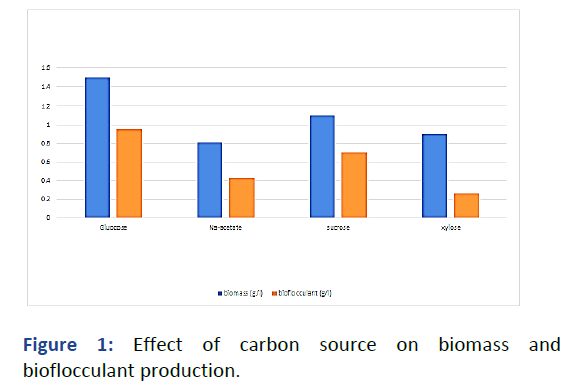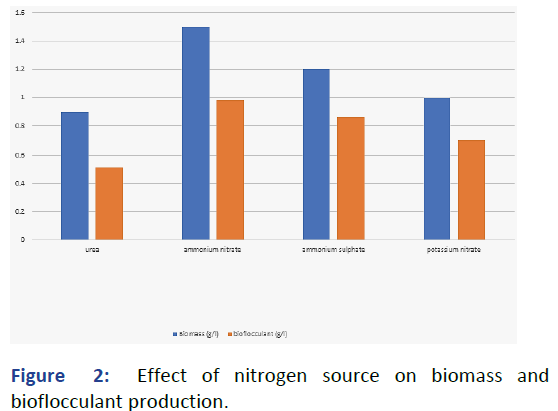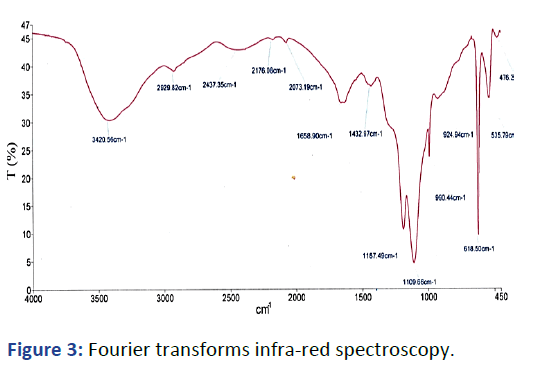Research Article - (2023) Volume 14, Issue 9
Received: 09-Apr-2023, Manuscript No. AASRFC-23-16111; Editor assigned: 11-Apr-2023, Pre QC No. AASRFC-23-16111 (PQ); Reviewed: 25-Apr-2023, QC No. AASRFC-23-16111; Revised: 09-Jun-2023, Manuscript No. AASRFC-23-16111 (R); Published: 16-Jun-2023
Bioflocculant are macromolecule polymers, such as proteins, polysaccharides, and lipids, which are secreted by microorganisms including algae, bacteria, actinomyces, and fungi. Biological flocculants are advantageous over chemicals due to their biodegradability and safety to living beings. In this study, garden soil, petrol pump soil, stagnant water, and sewage water from nearby Kalyan and Titwala location was collected and analysed for production of bioflocculant. A total of 26 isolates were obtained capable of producing bioflocculant. Isolate SW-4 isolated from effluent water was found to be potent bioflocculant producer. Based upon morphological and biochemical characteristics the isolate was identified as Bacillus subtilis. Among various carbon and nitrogen substrates used for bioflocculant production glucose and ammonium nitrate found to be the best carbon and nitrogen source respectively. The isolate at temperature 37°C and pH 7.0 gave 1.1 g L-1 of bioflocculant. The characterization of bioflocculant revealed it to contain protein (138 μg) and carbohydrate (32.8 μg). The FTIR analysis of the bioflocculant indicated it to be protein bound polysaccharide. The efficient flocculation capability of the bioflocculant obtained in this study therefore suggests its potential application in waste water treatment industries.
Bioflocculants; Macromolecules; Polymers; FT-IR; Waste water treatment
Flocculation is an essential parameter employed for the removal of suspended solids in domestic and industrial wastewater treatment. Flocculation is accomplished with the help of flocculants, which are either natural or synthetic substances that facilitate the aggregation of particles to form flocs. Flocculating agents are widely used in industrial fields such as dredging, textile dyeing, mining, pharmacology, cosmetology, wastewater treatment, food and fermentation processes. Flocculants are grouped as inorganic (aluminium salts), synthetic (polyacrylamide) and natural occurring flocculants (bioflocculants and chitosan). Inorganic and synthetic organic flocculants are extensively used in vast biotechnological applications due to their cost effectiveness. However, they are both reported to impose health risks and environmental hazards. Synthetic flocculants have shown adverse health effects such as neurotoxicity, carcinogenicity and cause Alzheimer’s diseases. Moreover, chemical flocculants are non-degradable and their by-products are often toxic. Owing to the short comings, the need for ecofriendly flocculants that impose less health threats is of high demand. Bioflocculants are macromolecules secreted by microorganisms due to substrate metabolism, microbial growth, cell lysis and degradation of microorganisms or microbial components. Bioflocculants lack secondary pollution and thus considered as environmental friendly substances. This is due to the special bioflocculant components (carbohydrates, proteins, nucleic acid and lipid), microbial flocculant matrix that show biodegradability adsorption abilities and hydrophilicity or hydrophobicity. However, production costs and low flocculant yields have been restrictive factors in the industrial applicability of bioflocculants. Moreover, the lack of knowledge of the active ingredients of most bioflocculants and the mechanism involved during flocculation also decreases their market potential have reported that the combination of strains of microorganisms in consortia produce bioflocculants that have better flocculating activity and higher bioflocculant yields than pure strains. Therefore, the search for new bioflocculants that are both biodegradable and display powerful flocculation capability is attracting much research attention. Various bioflocculants can be derived from different bacteria the produced bioflocculants can be optimized and characterized. According to the findings of screening for microorganisms with high bioflocculant producing capability and high flocculating efficiency is vital for success in this field. Furthermore, investigated the use of low cost substrates in growth media for bioflocculant production as a possible cost cutting measure. Some low cost substrates such as soybean juice, fishmeal wastewater have been documented as alternative nitrogen source components in production media. The constant development of industries and increase in population has led to the steady increase in the volumes of wastewater discharged into water bodies. Annually, approximately 109 m3 of wastewater is globally produced. About 30% of the generated wastewater is from municipal wastewater, whereas over 60% comes from industries, such as coal mines. The disposal of wastewater remains the main challenge, especially in third world countries where roughly 8% of wastewater is treated prior to being discharged. Water pollution imposes a threat to environment and human and animal health. More than 70% of disease cases in third world countries are associated with the consumption or drinking of polluted water. Thus, recently, much attention has been given to the treatment of wastewater. Thus the search for microorganisms with better flocculants producing abilities and reduced production costs continues among researchers in this field. In this study an attempt is made to isolate bioflocculant producing microorganisms from natural habitat that showed better qualities over synthetic flocculants and at the same time it can be used an ecofriendly approach to remove the pollutants from the nature [1-8].
Sample Collection
Soil from garden and petrol pump, Kalyan was collected in small box. Stagnant water from Titwala, chemical factory effluent from Shahad, sewage water from Kalyan and water from Ulhas river was collected in plastic bottles.
Isolation Medium
The supplemented nutrient broth medium used to isolate bacteria from the oil sample was containing per liter of 500 ml of nutrient broth and 500 ml mineral salt solution. The 500 ml of salt solution was prepared by adding the various salts such as K2HPO4, 20 g; K2HPO4, 5.0 g, (NH4)2SO4, 30 g; NaCl, 0.1 g; FeSO4.7H2O, 0.2 g; CaCl2.2H2O, 0.2 g; CaCl2.2H2O, 0.01 g; MnSO4.7H2O, 0.2 g; glucose, 0.03 % (w/v); and yeast extract, 0.03 % (w/v). One half of the SNB medium with 2% agar was used to isolate heterotrophs.
Pre-screening Medium
The prescreening medium used to select bioflocculant producing bacteria contained (per liter) 1% glucose, 0.35% yeast extract, 0.5% K2HPO4, 0.2% KH2PO4, 0.05% MgSO4. 7H2O, 0.01% NaCl and agar 1.5%.
Fermentation Medium
The fermentation medium contained (per liter) sucrose, 10 g; yeast extract, 1 g; urea, 1 g; KH2PO4, 0.1 g; K2HPO4, 0.1 g; NaCl, 0.1 g and MgSO4.7H2O, 0.2 g. The initial pH of media was adjusted to 7.2 to 7.5 with NaOH (1 M) and HCl (0.5 M). All the media were prepared in distilled water and sterilized at 121°C for 20 min.
Screening of Bioflocculant Producing Microorganism
The flocculating activity test was done in accordance with the method described. 4 g L-1 kaolin clay suspensions were used. 2ml of bioflocculant solution and 3 ml of 1% CaCl2 were added to 100 ml kaolin suspension, stirred for 1 minute, and held for 5 minutes. The supernatant was taken from the upper phase. A control was prepared by substituting the bioflocculant solution with deionized water and measured under similar conditions. Flocculating activity was then calculated using the following formula:
Flocculating activity (%) = ((A-B)/A) × 100
Where;
A=Optical density at 550 nm of control.
B=Optical density at 550 nm of sample.
Identification of Bioflocculant Producing Bacteria
The isolates giving flocculating activity were selected and studied for their morphological, cultural and biochemical characteristics as described. Morphological and cultural characteristics were studied by using nutrient agar and MacConkey’s agar (Hi-media).
Extraction of Bioflocculant
To partially purify bioflocculants, culture broths were centrifuged to remove cells by centrifugal separation (8000 g, 30 min). One volume of distilled water was added to the upper phase and centrifuged at 8000 g for 15 min to remove insoluble substances. To the supernatant, two volumes of ethanol were added, and the mixture was stirred and left to stand at 4°C for 12 hours. The precipitate was vacuum dried to obtain the crude bioflocculant. The crude product was directly dissolved in distilled water to yield a solution, to which one volume of the mixed solution of chloroform and n-butyl alcohol (5:2 v/v) was added. After stirring, the mixture was left standing at room temperature (about 20°C) for 12 hours. The upper phase was centrifuged at 3000 g for 15 min and two volumes of ethanol were added to recover the precipitate. After centrifugation at 3000 g for 15 min, the precipitate was vacuum dried and re dissolved in distilled water. After dialyzing against de-ionized water overnight the solution was vacuum dried to obtain a purified bioflocculant [9-14].
Characterization of Bioflocculant
Quantitative estimation of protein content of the bioflocculant was determined using Folin Lowry method carbohydrate content by phenol sulphuric acid method. The purified bioflocculant was characterized by using a Fourier Transform Infrared (FTIR) spectrophotometer. The dried bioflocculant powder was mixed with Potassium Bromide (KBr), ground and pressed into pellets for FTIR spectral measurement in the frequency range of 4000-370 cm-1.
Application of the Bioflocculant in Wastewater Treatment
Wastewater samples were collected from and Biochemical Oxygen Demand (BOD) and Chemical Oxygen Demand (COD) were measured before and after treatment with the bioflocculant. The measurements were performed using a spectrophotometer About 3 mL of 1% (w/v) AlCl3 ions and 2 ml of 0.4 mg/mL bioflocculant solution were mixed with 100 mL of wastewater sample in a 250 ml conical flask. The mixtures were agitated at 200 rpm for 3 min, and the speed was thereafter reduced to 40 rpm for 5 min.
The flasks were left at room temperature to stand for 10 min for sedimentation. For comparison, conventional flocculants such as alum and ferric chloride (0.4 mg/mL) were used. Thereafter, the percentage removal efficiency of the bioflocculant on BOD, and COD was measured by reading the optical densities at 680 nm. The following formula was used to calculate the bioflocculant removal efficiency.
Removal Efficiency (RE) (%) = Co−C/Co × 100
Whereby;
Co and C are the values before and after the flocculation
process measured at 680 nm, respectively.
Screening and Identification of Bioflocculant Producer
Despite so many studies about bioflocculants, flocculation activity and culture cost of bioflocculants are still the major limiting factor with regard to their application. From this study, Table 1 depict the total heterotrophic bacterial count indicating that stagnant water sample from Titwala showed highest number of total heterotrophic bacterial count followed by soil sample from petrol pump. All the samples showed 5-7 different types of colonies.
| Sr. no. | Sites | Total heterotrophic bacterial count | No. of different of colonies |
|---|---|---|---|
| 1 | Kalyan-garden soil | 2.0 × 107 | 5 |
| 2 | Titwala-stagnant water | 1.8 × 108 | 7 |
| 3 | Shahad-chemical factory effluent | 3.1 × 107 | 8 |
| 4 | Kalyan-petrol pump | 4.4 × 107 | 6 |
Table 1: Total heterotrophic bacterial count.
These 26 different colonies were selected and inoculated in prescreening medium for selection of bioflocculant producing bacteria. The flocculating activity with each of these isolates was calculated have isolated 36 bioflocculant producers from petroleum contaminated sites (Table 2).
| Site | Isolates | Flocculating activity (%) |
|---|---|---|
| Kalyan-garden soil | KG-1 | 25.6 |
| KG-2 | 29.2 | |
| KG-3 | 0 | |
| KG-4 | 34.5 | |
| KG-5 | 38.2 | |
| Titwala-stagnant water | TS-1 | 29.5 |
| TS-2 | 0 | |
| TS-3 | 0 | |
| TS-4 | 34.6 | |
| TS-5 | 39.2 | |
| TS-6 | 45.8 | |
| TS-7 | 30 | |
| Shahad-chemical effluent | SW-1 | 23 |
| SW-2 | 35.5 | |
| SW-3 | 0 | |
| SW-4 | 59.6 | |
| SW-5 | 49.4 | |
| SW-6 | 41.2 | |
| SW-7 | 32.8 | |
| SW-8 | 25 | |
| Kalyan-petrol pump | KP-1 | 34.6 |
| KP-2 | 12.5 | |
| KP-3 | 55.6 | |
| KP-4 | 43 | |
| KP-5 | 17.8 | |
| KP-6 | 47.8 |
Table 2: Screening isolates for flocculating activity.
The total 26 different isolates obtained from the different samples % isolates KG-5 from kalyan garden soil showed good flocculating activity. Similarly from Titwala stagnant water isolate TS-6 showed promising results. From Shahad chemical effluent isolates SW-4 and from Kalyan petrol pump isolate KP-3 was selected respectively (Table 2). The isolate which gave strong flocculating activity was identified based upon their morphological, cultural and biochemical properties (Table 3).
| Isolate | Name of the organism |
|---|---|
| KG-5 | Serratia |
| TS-6 | Bacillus polymyxa |
| SW-4 | Bacillus subtilis |
| KP-3 | Pseudomonas aeruginosa |
Table 3: The isolate and organism names.
Effect of carbon and nitrogen source: Although the biomass and flocculant activity was seen with all the four carbon source i.e., glucose, xylose sodium acetate and sucrose. Fermentation media supplemented glucose showed the high yield (Figure 1). Similarly among the nitrogen sources like ammonium nitrate, potassium nitrate, ammonium sulphate, urea tested, ammonium nitrate was found to give good yield and activity (Figure 2). Flocculating activity was maximum 59.6% with glucose followed by 50.6 with Na-acetate.

Figure 1: Effect of carbon source on biomass and bioflocculant production.

Figure 2: Effect of nitrogen source on biomass and bioflocculant production.
Characterization of the bioflocculant: From the standard graph for protein estimation and carbohydrate estimation the quantitative analysis of these components found that bioflocculant contain 138 μg of protein/mg, and the carbohydrate content was found to be 32.8 μg/mg [15-20].
Infrared spectrophotometry was used to analyze the purity of the bioflocculant as illustrated in Figure 3. Clear absorption peaks were observed at 3420.56, 2929.82, 2437.35, 2073.19, 1109.66, 924.94, 618.50, 535.79, and 476.32 cm-1. The absorbed stretching O-H band was at 3420.56 cm-1, and a vibration weak band of C-H was noted at 2929.82 cm-1 and 2073.19 cm-1. The peaks at 1658.90 cm-1 and 1432.97 cm-1 were attributed to C=O stretching and COOH vibration, respectively, other bands observed at 1109.66 cm-1 and 1187.49 cm-1 were identified to be classic characteristics of all compounds derived from sugar. Other absorption bands at 924.94 cm-1 and 990.44 cm-1 were related to the glyosidic bond linking the monomeric units present in sugars. The corresponding small band absorptions were observed at 446.32, 538.79, and 618.50 cm-1, which indicated that the bioflocculant was a protein bound polysaccharide.

Figure 3: Fourier transforms infra-red spectroscopy.
Application of bioflocculant in wastewater treatment: The bioflocculant produced by Bacillus subtilis was used to remove impurities such as BOD and COD in domestic wastewater. The biofrlocculant showed the removal efficiencies of 56% and 36% for BOD and COD respectively (Table 4). It is worth noting that the bioflocculant revealed the highest removal efficiencies than the conventional locculants tested, FeCl (31% and 33% for BOD and COD respectively) and alum (43% and 31% for BOD and COD respectively). Similar results were obtained by Pakraman H, et al. The effectiveness of wastewater treatment is mostly conveyed in terms of reduction in the Chemical Oxygen Demand (COD) and Biological Oxygen Demand (BOD).
| Types of flocculant | Removal efficiency (%) | ||
|---|---|---|---|
| BOD | COD | ||
| Bioflocculant | Before treatment | 1.6 | 270 |
| After treatment | 0.7 | 172 | |
| FeCl3 | Before treatment | 1.6 | 270 |
| After treatment | 1.1 | 180 | |
| Alum | Before treatment | 1.6 | 270 |
| After treatment | 0.9 | 186 | |
Table 4: Removal efficiency of bioflocculant on domestic waste water.
The four isolates from contaminated sites two belonging to Bacillus spp., other Serratia spp. and the prominent bioflocculant producer identified as Bacillussubtilis. The best carbon and nitrogen source was found to be glucose and ammonium nitrate respectively, wherein flocculant activity was found to be around 59%. The chemical characterization and FTIR analysis revealed that the bioflocculant is the protein bound sugar compound. The efficient biomass and bioflocculant activity makes this a good alternative against chemical flocculant which prove hazardous to environment. Thus, the bioflocculant obtained in this study can be an ecofriendly approach to clean our environment without any harmful end product.
[Crossref] [Google Scholar] [PubMed]
[Crossref] [Google Scholar] [PubMed]
[Crossref] [Google Scholar] [PubMed]
[Crossref] [Google Scholar] [PubMed]
[Crossref] [Google Scholar] [PubMed]
[Crossref] [Google Scholar] [PubMed]
[Crossref] [Google Scholar] [PubMed]
[Crossref] [Google Scholar] [PubMed]
[Crossref] [Google Scholar] [PubMed]
[Crossref] [Google Scholar] [PubMed]
Citation: Shekhawat DB, Dhaliwal MK (2023) Isolation of Bacterial Bioflocculant Producers and its Application in Waste Water Treatment. Adv Appl Sci Res. 14:41.
Copyright: © 2023 Shekhawat DB, et al. This is an open-access article distributed under the terms of the Creative Commons Attribution License, which permits unrestricted use, distribution, and reproduction in any medium, provided the original author and source are credited.